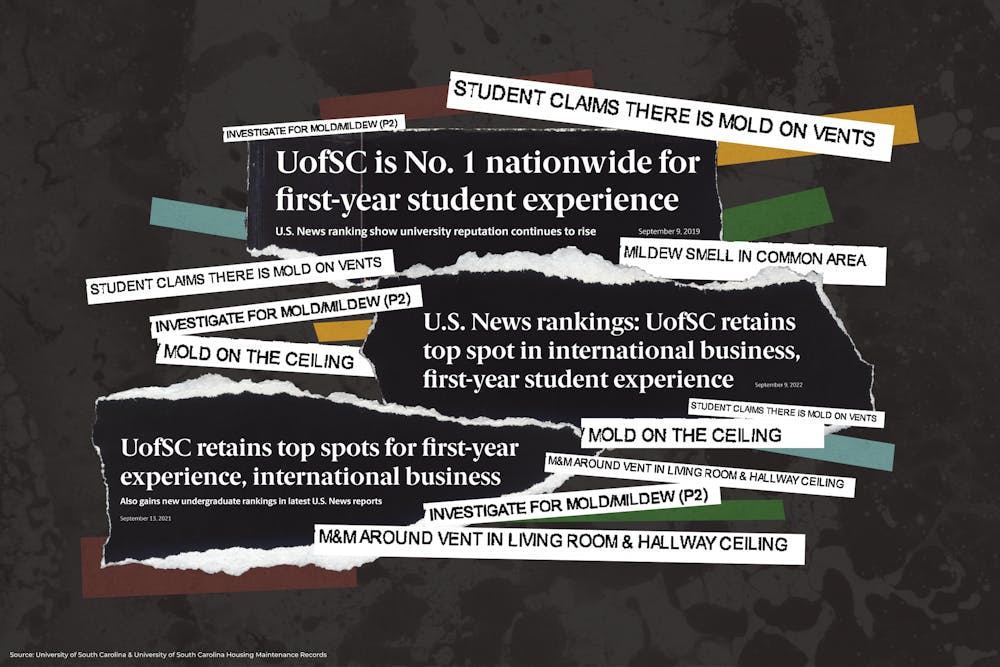Walking down Pickens Street in either direction, students see banners that boast about some of USC’s accomplishments hung from light posts like flags on the rafters of basketball arenas. One of these banners says USC has the nation’s best first-year experience.
While the university was ranked best in the nation in 2021, it ranked No. 3 in 2022. Many freshmen are required to live on-campus and take U101, a university program that plays a key factor in meriting the nation's best first-year experience.
What doesn’t help the supposed nation’s best first-year experience is mold growing in dorms and getting students sick — something the university tries its best to avoid discussing.
Mold in dorms is an issue almost all students are aware of, but its controversy leads the university to hide behind unverified statistics or blame students for the issues. Students deserve transparency.
Students reported at least 840 mold-related issues to university housing since August 2020. The Daily Gamecock recently collaborated with the Post and Courier for their investigative series, Uncovered, to comb through almost 1,400 work orders, contact more than 100 people and interview more than 20 students.
The documents only became available after The Post and Courier filed a FOIA request and paid a $1,800 fee to the university. The price was negotiated down from the university's initial request of about $12,000. The university's dated computer system meant staff had to manually sort through work orders. USC doesn't have an efficient way to track how many mold complaints students make.
"As we are trying to be really fiscally sound and responsible, that would be another whole person who just tracks that," April Barnes, the executive director of university housing said, in a previous interview with The Daily Gamecock.

The university is expected to install a new computer system next year for tracking mold-related work orders. Housing was unable to answer how long the university has been tracking orders manually or how much the current system costs.
What’s more concerning is that housing is possibly training orientation leaders to downplay mold for incoming freshmen. Second-year criminal justice student Leah Camilli, a former Capstone House resident, trained last summer to become an orientation leader. Her training included a module by housing that instructed orientation leaders to tell students that almost all complaints about mold are actually mildew.
"We talk about healthy living environments," Wise said. "Oftentimes, students that report mold in the buildings, a majority of the time — it's in the 90% range — the reports that come in are not mold. It may be mildew."
What Camilli is being told is deceptive. Mold and mildew are filed the same on FIXX work orders.
"Mold and mildew is, in essence, the same thing, because mildew could turn into mold," said Roderick Howell, the director of facilities.
Camilli said she was sick around 80% of the year. Her grades dropped, and if she couldn’t have driven the 20 minutes to go home often, her GPA and health might have gotten worse.
"I was down for the count for like two weeks taking NyQuil (and) DayQuil every single day," Camili said. "I had to go home because of how bad (living in my dorm) was."
Upon move-out, Camilli discovered a black mass of mold growing behind her bed. She estimated it was a full square foot of black mold growing behind her head.
Allergies — not just mold — could cause this type of reaction, housing said.
"A lot of times the thing that will jump-start a conversation for a student about mold is typically a reaction of an allergy," Wise said.
Housing estimates that around 90% of reports for mold in dorms turn out to not be mold. But of the 840 mold complaints students filed in the past two years, maintenance confirmed about half of them were mold.
While students can play a role in mold growing in dorms by not cleaning their rooms or leaving damp items like towels lying around, students are getting sick from conditions that aren't always in their control. Not every student's escape from their dorm is 20 minutes away.
Capstone, Columbia Hall and South Tower make up the bulk of the mold-related work orders made in the last two years. They are unrenovated dorms with ventilation issues. Many windows don't open. The more time the university neglects to prevent potential mold growth in three of the oldest dorms on campus, the more risk that mold could grow, potentially making students sick.
Although there are systemic blockages to renovating dorms and making housing safer, the university said it's here to help. Housing’s number one priority is to the students, not to the university’s bottom line or the so-coveted nation’s best first-year experience title.
Until the university prioritizes spending money on renovating old campus dorms, the potential mold issues will not be resolved.

